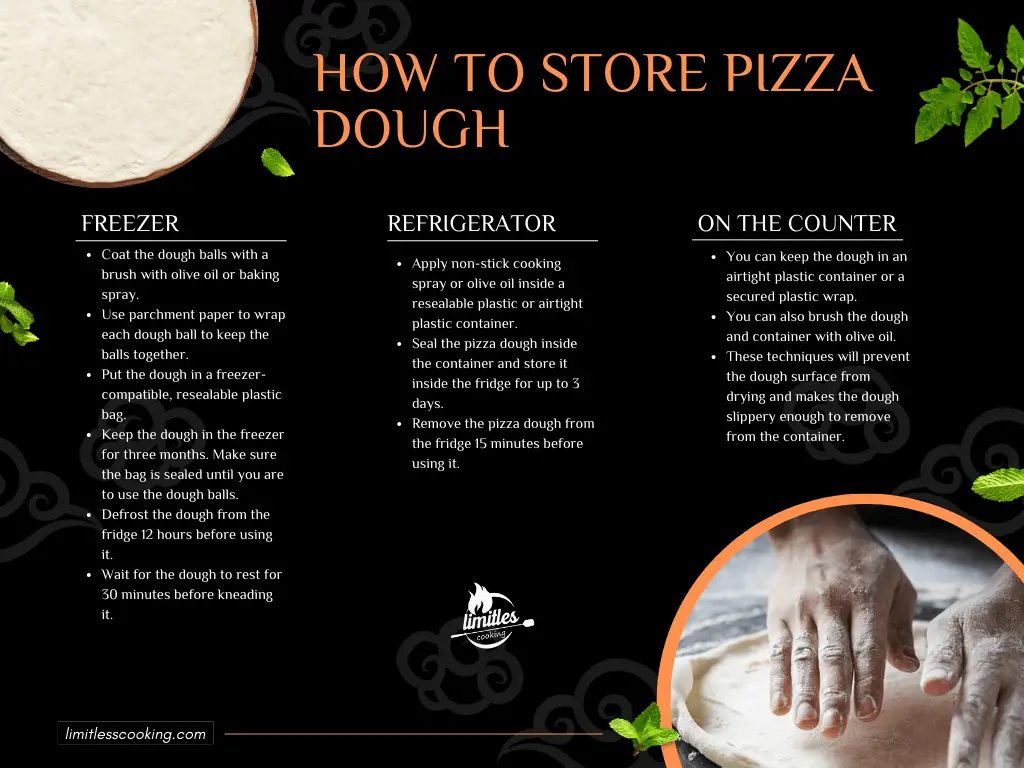A Practical Guide on How to Store Pizza Dough

A pizza can be quickly baked at home using dough. However, the whole dough is not used, and you will expect some extra dough. If you are a pizza fan, you definitely would want a pizza dough that will last long for your next baking.
Pizza dough will last depending on the amount of yeast used, the dough’s temperature, and the type of storage. However, dough left for a long time will overproof, and lose shape and texture, leading to a poorly structured dough. You would not want a pizza dough that cannot keep a good shape.
What are the best ways how to store pizza dough and still have a kneadable, delicious dough? Read this article to discover more about pizza dough storage – conditions, the temperature needed, and proper storage containers.
How to Store Pizza Dough: The Best Techniques
One of the essential things in making a perfect pizza is having a well-formed pizza dough. Once the dough is made of the right flour type, temperature, storage, and room temperature, it can hold for a few hours.
However, holding pizza dough for long before using them is not that good. Resting the pizza dough long will weaken the gluten strains and lessens the yeast’s ability to produce gas to inflate the dough. You eventually have a dough with an imperfect form, which will not look good with your pizza toppings. Storing an overnight pizza dough can be a big challenge then.
To prevent a pizza disaster and promote more extended storage, let’s determine the proper pizza dough holding and the different ways of dough storage.
Factors that Affect Dough Structure
The structure of pizza dough is affected by the following elements:
Type of Flour
The type of flour hugely affects how long the dough can last. Doughs with high gluten flour can withstand longer temper times compared to doughs with weaker flours. This characteristic can make the dough last long.
Amount of Yeast in the Dough
The amount of yeast in the dough affects the speed of fermentation. The more yeast the dough has, the faster the dough will rise and quicker the fermentation. Pizzas like Neopolitan pizza have lesser yeast, which causes them to grow slowly and last for an extended time.
Temperature of the Dough
A dough that has a higher temperature usually rises and holds longer.
You may also like: How to make homemade pizza with store-bought dough
Room Temperature
The recommended room temperature to make a dough rise is around 60 – 62 degrees Fahrenheit. Faster dough rising time occurs in hotter weather like summer than in colder weather.
Having a well-formed pizza dough is not enough. You need to determine the best ways to store the dough to maintain its form and freshness. Can you refrigerate pizza dough after it rises? Yes, by reading on the next tips of keeping pizza dough.
Ways of Storing Pizza Dough
After baking your pizza dough, you should bake one large dough and divide it into two to three parts. You can leave the dough for 1 to 2 hours inside an oiled plastic container. You can also keep the remainder of the dough inside cold storage.
Here are the different ways of storing your pizza dough:
On the Counter
Typical pizza dough can stay out on the counter for 2 to 4 hours. However, you can leave a pizza with a lesser yeast like a Neopolitan pizza for up to 24 hours.
You can keep the dough in an airtight plastic container or a secured plastic wrap. You can also brush the dough and container with olive oil. These techniques will prevent the dough surface from drying and makes the dough slippery enough to remove from the container.

In the Fridge
You can keep the pizza dough inside the fridge for two weeks. Keeping a frozen pizza dough inside the refrigerator will delay the fermentation process but not stop it entirely. Therefore, it is recommended to adjust the amount of yeast to keep your dough for an extended time.
The flavors are best retained within 3 to 5 days. Thus, it is better to have frozen pizza dough if you will not use it within seven days to avoid being overproof.
Storing Pizza Dough in the Fridge
Here are the steps in refrigerating the pizza dough:
- Apply non-stick cooking spray or olive oil inside a resealable plastic or airtight plastic container.
Ensure the dough is thoroughly kneaded before storage. You can utilize a baking spray or olive oil to coat the insides of the plastic container gently. This action is to prevent sticking of the dough. You can also form balls from the dough before storing it in the container.
- Seal the pizza dough inside the container and store it inside the fridge for up to 3 days.
Put the dough in the container and secure it with a lid or tight plastic wrap. The dough will gradually expand and acquire flavor in 3 days. The longer the dough is kept, the more it will expand inside the fridge.
- Remove the pizza dough from the fridge 15 minutes before using it.
Remove the lid from the container and wait for the dough to warm for 1 to 2 hours before cooking it. It helps it return to a suitable temperature for stretching and kneading.
You may also like: How to Steam Chicken in a Rice Cooker
- Push the dough down after it warms up.
Form a fist and punch the dough down to decrease its size. This action reshapes the dough into a ball and frees the gas bubbles formed from the yeast. Leave the dough for another 15 minutes after punching it.

In the Freezer
If the pizza dough will be used after a long time or kept as a readily available dough, you can keep it inside the freezer. It is always convenient to have the extra dough to duplicate your pizza recipe easily. The fermentation stops entirely when the dough is stored inside the freezer. The dough can last for three months in the freezer.
Storing Pizza Dough in the Freezer
Before storing it inside the freezer, it would be better to keep the dough first for 1 to 2 hours at room temperature. You can then divide the dough into small portioned dough balls before placing it inside the plastic containers. You can also use ziplock bags to contain your dough since it conserves space and has airtight properties.
Remove the dough out of the freezer and leave it inside the fridge to thaw overnight. After that, take the doubt out of the fridge 30 minutes before baking the pizza dough.
- Coat the dough balls with a brush with olive oil or baking spray.
Gently spray the dough with baking spray or apply a thin layer of olive oil on the dough. Apply the oil or spray all over the surface of the dough balls. This action prevents the balls from attaching with each other or into the container.
Dough balls are quicker to store so that you can thaw the dough one by one. You can rub the oil or spray using a kitchen brush to avoid oil from touching your hands.
- Use parchment paper to wrap each dough ball to keep the balls together.
Small cuts of parchment paper can be wrapped on the dough balls to keep them from sticking together. You don’t need to wrap the pizza dough if you keep the balls in individual bags.
- Put the dough in a freezer-compatible, resealable plastic bag.
Place dough in freezer-safe bags. Keep the bag airtight, with the air out for compact and easy storage. You can also use a resealable plastic container for the same purpose.
- Keep the dough in the freezer for three months. Make sure the bag is sealed until you are to use the dough balls.
Get one of the balls every time you want to cook a pizza. The dough may have a freezer burn after three months.
- Defrost the dough from the fridge 12 hours before using it.
Remove the bag from the freezer and put it inside the fridge. Place it inside the freezer overnight or within 12 hours for a kneadable dough.
- Wait for the dough to rest for 30 minutes before kneading it.
Place the dough in a bowl on the counter to warm the dough to room temperature. This action will make the dough kneadable.
FAQ
What is the best temperature for storing pizza dough?
The best temperature for the storage of dough will be between 0 to -3 degrees Fahrenheit. This temperature range maintains the freshness of the dough, safe from ice crystals or contamination.
What can you create out of old pizza dough?
You can make wonderful use of your old pizza dough. Turn it into scallion pancakes, crackers, dinner rolls, pretzels, breadsticks, pita bread, monkey bread, and donuts.
What happens when you use gluten in your pizza dough?
Gluten is vital as it helps in forming a stretchy texture on the dough without breaking it. It maintains the form of the dough.
Conclusion
There are many ways on how to store pizza dough, from placing it on the counter to the fridge and freezer storage. Ensure that the right room temperature, hydration, amount of yeast, and flour type are considered to ensure the freshness, form, and moisture of the dough. So pack the pizza dough properly, store the dough well, and enjoy the best, delicious dough for your pizza!






